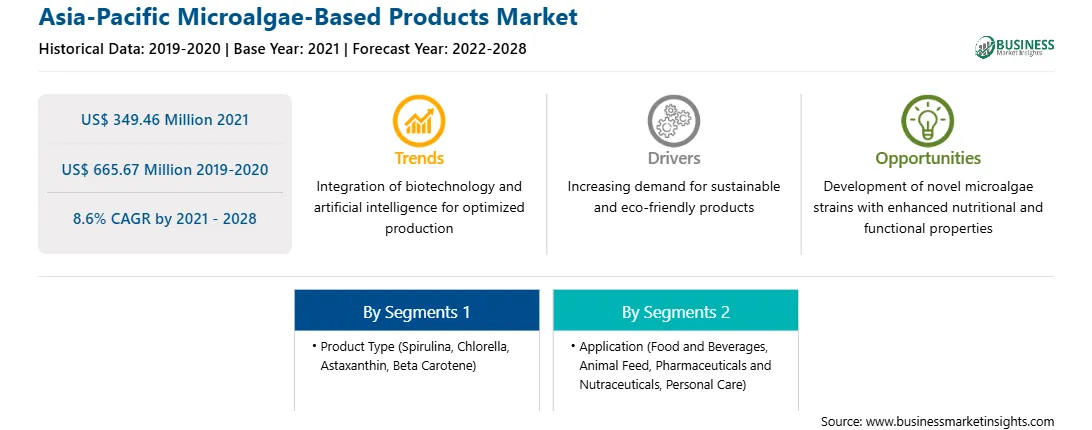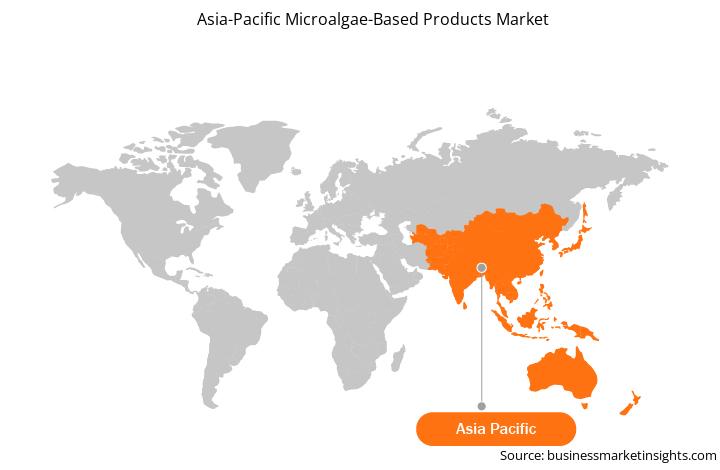The microalgae-based products manufacturing industries in Japan, India, China, South Korea, Singapore, Taiwan, and Indonesia, among others, is growing at significant rates. These emerging countries are witnessing an upsurge in industrialization and urbanization activities, offering ample opportunities for the key market players in the microalgae-based products market. The microalgae-based products industry in the countries of APAC has experienced a considerable shift over the years. The massive growth of the Asia-Pacific region market is due to the rising investment in sustainable and bio-based solutions in emerging economies, such as India and China. Furthermore, favorable government policies attract many new and international players to set their microalgae-based products manufacturing plants in China, India, and Japan. Over the years, the investments in the end use sectors such as food and beverage, pharmaceutical and nutraceutical, animal feed and other sectors in this region have risen considerably and are further likely to grow at a significantly high pace. The key players are establishing their manufacturing bases in countries such as China, Japan, India and other Asian economies due to availability of cheap labor and low-cost production conditions. Growth in research in applications and commercial viability of microalgae is the major factor driving the growth of the APAC microalgae-based products market.
The COVID-19 pandemic is anticipated to cause a significant economic loss in Asia-Pacific. The consequence and impact can be even worse, and they totally depend on the spread of the virus. The Asian economies have been hit hard due to the pandemic. Currently, India has recorded the highest number of cases, which is 31,411,262, with 420,996 deaths as of July 26, 2021. The emergence of new COVID-19 waves in India, Thailand, and other Asian economies has prolonged the effect of pandemic upon GDP. The ongoing COVID-19 pandemic is anticipated to cause huge disruptions in the growth of various industries of Asia-Pacific. However, the uncertainty regarding the future outbreak, especially in countries such as India and few other Asian countries, has altered the status of several industrial sectors. The governments of various Asia-Pacific economies are taking possible steps to restrict the spread of the virus by announcing country-wide lockdown, which have a direct impact upon the growth of industrial sectors. This may impact the demand for microalgae-based products. However, the market is expected to witness an increase in investment by existing players along with penetration of new players to tap the prevailing opportunities as well as cater to soaring demand for natural, healthy, clean-label products in post-pandemic times.

Strategic insights for the Asia-Pacific Microalgae-Based Products provides data-driven analysis of the industry landscape, including current trends, key players, and regional nuances. These insights offer actionable recommendations, enabling readers to differentiate themselves from competitors by identifying untapped segments or developing unique value propositions. Leveraging data analytics, these insights help industry players anticipate the market shifts, whether investors, manufacturers, or other stakeholders. A future-oriented perspective is essential, helping stakeholders anticipate market shifts and position themselves for long-term success in this dynamic region. Ultimately, effective strategic insights empower readers to make informed decisions that drive profitability and achieve their business objectives within the market.

| Report Attribute | Details |
|---|---|
| Market size in 2021 | US$ 349.46 Million |
| Market Size by 2028 | US$ 665.67 Million |
| CAGR (2021 - 2028) | 8.6% |
| Historical Data | 2019-2020 |
| Forecast period | 2022-2028 |
| Segments Covered |
By Product Type
|
| Regions and Countries Covered | Asia-Pacific
|
| Market leaders and key company profiles |
|
The geographic scope of the Asia-Pacific Microalgae-Based Products refers to the specific areas in which a business operates and competes. Understanding local distinctions, such as diverse consumer preferences (e.g., demand for specific plug types or battery backup durations), varying economic conditions, and regulatory environments, is crucial for tailoring strategies to specific markets. Businesses can expand their reach by identifying underserved areas or adapting their offerings to meet local demands. A clear market focus allows for more effective resource allocation, targeted marketing campaigns, and better positioning against local competitors, ultimately driving growth in those targeted areas.

The microalgae-based products market in APAC is expected to grow from US$ 349.46 million in 2021 to US$ 665.67 million by 2028; it is estimated to grow at a CAGR of 8.6% from 2021 to 2028. Microalgae-based products have received the GRAS (i.e., Generally Recognized As Safe) status, which makes them suitable for pharmaceutical and nutraceutical applications. Microalgae are known for their antibacterial, antioxidant, antiviral, antimalarial, antifungal, antitumor, and anti-inflammatory activities. They are a source of vital phytochemicals such as carotenoids, fiber, minerals, antioxidants, fatty acids, vitamins, halogenated compounds, polysaccharides, and lectins and other proteins. For instance, polyunsaturated fatty acids (PUFA) present in microalgae are potential therapeutic agents that also minimize the risk of chronic disorders such as cardiovascular disorders, diabetic diseases, Alzheimer’s disease, and retinal problems. Similarly, cyanobacteria (blue-green algae) are increasingly being used in the synthesis of antibiotics and pharmacologically active compounds. Further, Chlorella tablets have been proven to be effective in the treatment of nausea, vomiting, and other gastrointestinal issues. Likewise, carrageenan from red algae is effective against Influenza virus. Natural products sourced from different variants of algae serve as the basis of drug discovery and find application in the formulation of medicines. Further, researchers are developing genetically engineered algae that could help in killing harmful cancerous cells. Several countries are focusing on development of COVID-19 vaccine with the help of microalgae.
On the basis of product type, the APAC microalgae-based products market is categorized into spirulina, chlorella, astaxanthin, beta carotene and others. The spirulina segment dominated the market in 2020 and astaxanthin segment is expected to be the fastest growing during the forecast period. Based on application, the microalgae-based products market is categorized into food and beverages, animal feed, pharmaceuticals and nutraceuticals, personal care and others. The pharmaceuticals and nutraceuticals segment dominated the market in 2020 and food and beverages is expected to be the fastest growing during the forecast period.
A few major primary and secondary sources referred to for preparing this report on microalgae-based products market in APAC are company websites, annual reports, financial reports, national government documents, and statistical database, among others. Major companies listed in the report AstaReal; Cargill, Incorporated; Cyanotech Corporation; E.I.D. - Parry (India) Limited; Earthrise Nutritionals, Llc; Euglena Co, Ltd; and Far East Bio-Tec Co., Ltd are among others.
The Asia-Pacific Microalgae-Based Products Market is valued at US$ 349.46 Million in 2021, it is projected to reach US$ 665.67 Million by 2028.
As per our report Asia-Pacific Microalgae-Based Products Market, the market size is valued at US$ 349.46 Million in 2021, projecting it to reach US$ 665.67 Million by 2028. This translates to a CAGR of approximately 8.6% during the forecast period.
The Asia-Pacific Microalgae-Based Products Market report typically cover these key segments-
The historic period, base year, and forecast period can vary slightly depending on the specific market research report. However, for the Asia-Pacific Microalgae-Based Products Market report:
The Asia-Pacific Microalgae-Based Products Market is populated by several key players, each contributing to its growth and innovation. Some of the major players include:
The Asia-Pacific Microalgae-Based Products Market report is valuable for diverse stakeholders, including:
Essentially, anyone involved in or considering involvement in the Asia-Pacific Microalgae-Based Products Market value chain can benefit from the information contained in a comprehensive market report.